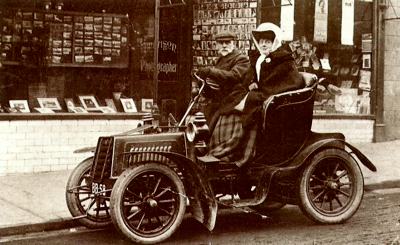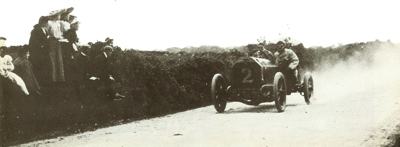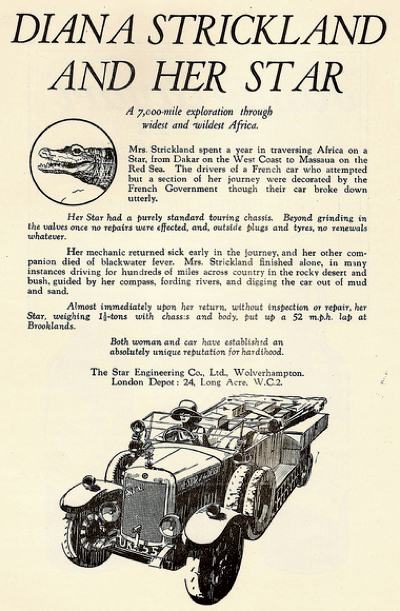The Star Engineering Company
|
1897 - 1932 |
Country: |
 |
|
Sharratt and Lisle
The Star Engineering Company of Wolverhampton dates back to 1883, when two skilled cycle mechanics named Sharratt and Lisle decided to go into business on their own account. They named their products Star Cycles. Eventually, the firm of Sharratt & Lisle was enlarged and floated as a public company, with Edward Lisle as managing director and chief proprietor: Lisle was a pioneer motorist, and decided to embark on the manufacture of cars in 1897. That year a
prototype was built which followed very closely the lines of the contemporary Benz, and this formed the pattern for the production models which made their appearance the following year.
In 1898 Star issued their first catalogue: 'Three-and-a-half horsepower single cylinder water cooled motor; belt and chain driven; two speeds; electric ignition; Star carburettor which is equally effective in any weather; two independent powerful handbrakes are fitted; petrol tanks have a capacity of supply for about 100 miles run under favourable conditions. The car is fitted with lamps, horn and a complete set of tools, oil cans, etc.
Star's First Export Order, Auckland, New Zealand
Star also received their first export order, from Auckland, New Zealand; and Star were also in demand by other motor companies as manufacturers of cycle-type wire-spoked wheels for pneumatic tyres. The business began to expand rapidly, overflowing from the original factory in Frederick Street into a network of additional cramped backstreet factories in Dudley Road, Nelson Street, Stewart Street, Ablow Street and Dobb Street. It was at the Frederick Street site that the Star's foundry was located, manufacturing metal castings for the vehicles made by the company. The entrance to the large two-storey building was through a pedimented doorway.
By 1900, the output of cars was claimed to be twenty a week. A twin-cylinder model with three forward speeds was introduced in 1900, and that year Star cars appeared in the Automobile Club Show at Richmond and in the 1000 Miles' Trial: the car entered in the latter event was one of the two-speed voiturettes, which broke a stub-axle, a spring, two spokes and two lower frame tubes on the road between Preston and Lancaster. Its crew managed a 'lightning change' and replaced all the broken parts in time for the car to reach the stage end at Kendal at 2.30 am that night, so that it could start on time the following morning.
The Hereford Light Car Trial of 1904
As far as design went, Star were dedicated followers of fashion: now that the Benz design was becoming obsolescent, they turned to the more up-to-date Panhard for inspiration, and in 1901 launched a new model with a vertical 7 hp twin-cylinder engine mounted at the front behind a gilled-tube radiator. One of these cars was entered for the Hereford Light Car Trial of 1904, and managed to gain a medal and certificate for reliability and non-stop performance. There was also a light car with a single-cylinder De Dion power unit. Edward Lisle had been a keen racing cyclist in his day, and realised the importance of competition success, and entered his cars for every test or competition for which they were eligible.
Again deciding to copy the leaders of fashion, in 1903 Star based their next new models on the Mercedes, introducing a 12 hp four-cylinder model, with pressed-steel chassis, honeycomb
radiator and mechanically-operated inlet valves. In a speed trial organised at Cork by the Irish Automobile Club, one of these new models set a new speed record of 39 mph for two miles from a standing start. That year, two racing cars were built for the Gordon Bennett Eliminating Trials on the Isle of Man; though neither managed to qualify, one was appointed a pilot car to clear the Gordon Bennett course of traffic before the race actually started.
A new 14 hp four-cylinder Star was introduced for the 1906 season, and in February 1906 one of these 3261cc models was supplied to the Automobile Club of Great Britain and Ireland for use by club officials. That year also saw the debut of Star's first six-cylinder model, the 6227cc 30 hp, which, with an increase in bore size in 1909 which increased the swept volume to 6981cc, was listed until 1911. The 'many and varied types of cars, in the rare beauty and excellence of which series we take delight' now produced by Star consisted of a 7 hp twin, fours of 10 hp, 14 hp and 18 hp as well as the 30 hp six; but this variety was not, it seems, sufficient.
The Starling and Stuart
By this time, car manufacture was being carried out by the Star Engineering Company under Joseph Lisle, Edward Lisle's eldest son; the cycle and motor cycle side of the business was managed by Edward Lisle Jr, and in 1906 this company began building single-cylinder voiturette with 940cc De Dion power units under the name Starling. The following year another single cylinder Starling appeared, this time of 1296cc, and a twin cylinder car of 1531cc, marketed as the Stuart in 1907 and as a Starling thereafter. These chassis were also supplied to F. Hopper, cycle manufacturers of Barton-on-Hurnber, Lincolnshire, who marketed them as'Torpedos'.
 1904 Star.
1904 Star.
 F. R. Goodwin in one of two Star's that competed in the 1905 Gordon Bennett eliminating trials on the Isle of Man. Unfortunately, both 10 litre cars were unsuccessful.
F. R. Goodwin in one of two Star's that competed in the 1905 Gordon Bennett eliminating trials on the Isle of Man. Unfortunately, both 10 litre cars were unsuccessful.
 1914 Star 15.9 hp tourer, powered by a 3012cc engine. It would remain in production for ten years.
1914 Star 15.9 hp tourer, powered by a 3012cc engine. It would remain in production for ten years.
 Diana Strickland drove her "Star of the Desert" over 7000 miles through Africa.
Diana Strickland drove her "Star of the Desert" over 7000 miles through Africa. |
The Briton Motor Company
In 1909 the Star Cycle Company changed its name to the Briton Motor Company, and built a new factory expressly intended for car production between Walsall Street and Willenhall Road, in Wolverhampton. The idea was to produce the Briton car as a lower-priced model with all the traditional Star virtues, and initially two models were produced, a 2282cc 12 hp twin and a four-cylinder 14hp of 2413cc, the latter also becoming available in Star form the following season. A 10 hp Briton appeared in 1913, with a 1743cc engine, priced at UK£183; the following year it became the 10/12.
The Last 4 Briton's Are Shipped to Australia
Small cars were still the staple offering of the Briton Motor Company after World War 1, when a 1373cc ohv model formed the backbone of their range, but Briton went under in the post-war slump in 1922, and were bought by C. A. Weight, who resumed production with a 1372cc side-valve model. Sales were not up to expectations, and so Weight began producing tractor components. This side of the business soon dominated Briton's activities, and the last four Briton cars were shipped to Australia in 1929, after some 1000 had been built under the Weight regime.
New Zealand's National Hill Climb Champion
As for the Star Engineering Company, their products were going from strength to strength. They had built up a good export trade, and in 1908 sporting successes were reported from the Transvaal, where a 14hp Star won the Transvaal Automobile Club's hill-climb plus a gold medal for reliability, and from New Zealand, where another 14hp Star was the national hill-climb champion. In the UK Stars did well in the 1909 Irish Reliability Trial and in the Scottish AC Trial, the 12 hp winning all the hill-climbs in its class, and scored maximum marks in the fuel consumption contest.
In the same event, a new 2862cc 15 hp model made its debut, and won a special medal. Actually of 19.6 rated horsepower, this model survived for three seasons, and was the succeeded by the classic 15.9 hp Star, of 3016cc. This was a long-stroke development of the 12 hp 2413cc model announced for 1911: but the 12 hp nomenclature was applied to a wide number of models, whose only common factor was that none of them was actually rated as low as 12 hp on the RAC taxation formula.
The Henry Edwards Trophy
The first Star 12 made its debut in 1908-9; it had an engine of 84 mm x 115 mm and was rated at 17.5 hp, having a swept volume of 2549cc. A new 12 was announced for 1910, with a 82 mm x 127 mm engine, a rating of 16.7 hp and capacity of 268cc3: one of these cars won the Henry Edwards Trophy at Shelsley Walsh, setting up a ne, record on formula for the hill. This 12 lasted only on season, and was replaced by the 2413cc version (which was taxed at 15:9 hp). The new version had 80 mm x 120 mm cylinders. In its first year, the RAC organised a race for standard touring cars of 80 mm bore, and two Star 12s were entered. The event consisted of a 277-mile race at
Brooklands, and one Star came first with an average speed of 56
½ mph, while the other was third having averaged 56 mph.
Then, in 1912, appeared the 80 mm x 150 mn 15.9 hp model, one of which ran for 12 hours under RAC observation on
Brooklands, covering 801 miles non-stop at an average of 66.75 mph. For 1914 this chassis and its larger sister car, the 3817cc 20.1 hp were available with streamline torpedo coachwork set off by handsome bull-nosed radiators, originally, it seems, developed for the colonial model Stars to give 'ample cooling surface', but so aesthetically right that they were annexed for the UK market, too.
The war saw Star, by now one of the six biggest motor producers in Britain, producing large number of motor vehicles for the British, French and Russian governments, as well as a substantial output of shells. But peace found the company with a large factory magnificently equipped and a greatly reduced market for its product. Prior to the war the company had expanded into the commercial motor vehicle market with considerable success and profit, but thanks to the considerable impetus the American heavy motor vehicle industry gained from war time production, that market remained effectively closed to Star for some years after 1918.
The old 15.9 hp and 20.1 hp chassis were revived as the basis of immediate post-war production, while design began of an up-to-date model more suited to post-war motoring requirements. This made its debut in the summer of 1921, in the shape of a side-valve 1795cc model of conventional design and the traditional Star quality of construction. Edward Lisle Sr died in 1922, and Joseph Lisle took over complete control of Star. This year also saw Star's re-entry into competition, with two cars taking part in the Scottish Six Days' Light Car Trials. Driven by R. Lisle and G. G. Cathie, the Stars came first and second in their class.
Fast on Hills, Economical on Fuel
Commented Motor News: 'Fast on hills and economical on fuel, 34 miles to the gallon over such a route is excellent. The Gold Medal was indeed theirs on a ton mileage basis among all the cars in the Trial. The Motor claimed 'No praise too high is there for the two Stars, which seemed to face every obstacle sturdily and surmount it surely every day of the trial. Both Stars created a sound and lasting impression in the minds of those who saw them, for they never once faltered. Sturdily built, handsome and economical, they won their laurels in no uncertain manner.'
The Australian 1000-Mile Alpine Test
The winning car was shipped out to Australia, where it covered some 11,000 miles before being shipped to New Zealand, where it reduced local records held by large high-powered cars. Another 11.9 hp carried off the honours in the Australian 1000-Mile Alpine Test, 'all scenery and shell-shock', a feat which helped to boost sales to the colonies. In 1924 the 11.9 hp model matured into the 12/25 hp, with a 1945cc engine; before long, there was also a 12/40 hp version, which had pushrod ohv and four wheel brakes, was claimed to be capable of 5000 rpm and 80 mph, and had a four-speed gearbox for improved acceleration. There was also a six-cylinder version of the 12/25, known as the 18/40, and Star also offered a commercial vehicle range of 25 cwt, 34-40 cwt and 50-60 cwt trucks, all fitted with 20/25 hp power units.
Compared with other makes of car, the Star was relatively expensive, a fact which militated against sales in the highly competitive mid-1920s. Apparently oblivious to the then current market trends, Star set about making their range as complex as possible. In 1926 a four cylinder ohv 14/40hp of 2120cc joined the line-up, soon augmented by a six-cylinder variant, the 20/60, of 3181cc. These had massive crankshafts, running in five main bearings on the four, and seven on the six, with duralumin connecting rods and cast-iron pistons. There were now three side-valve models and three ohv, all available in a number of different body styles.
The Comet and Planet
The inevitable happened in 1928, and Star were taken over by another Wolverhampton manufacturer, Guy, who were more interested in the advanced Star Flyer commercial vehicle chassis than in the car range. The last new car introduced under the old regime had been the 18/50 hp six of 2470cc, with wet-liners, duralumin conrods, aluminium pistons and a seven-bearing crank. It was this model and the 20/60 hp which were to form the basis of Star's subsequent output, and in 1930 they were totally redesigned as the Comet and Planet ranges, built in Guy's Bushbury, Wolverhampton, factory, and offering '1941 motoring luxury and economy in a 1931 car'.
All 18 hp Comets were £495, all 20 hp Planets £695: their full specification including four-wheel hydraulic jacking, servo-assisted brakes, thermostatically-controlled
radiator shutters, one-shot chassis lubrication, sunshine roof and a fog lamp. Two alternative power units of 14 hp and 24 hp were announced for 1932, but the Comet and Planet were proving uneconomically expensive to build. In March 1932 production was suspended, and all the cars and spares in stock sold to McKenzie and Denley, of Birmingham. As late as 1962 H. B. Denley was still advertising Star cars and components for sale - but the trail seems to have gone cold from there.



